Italian "Infernal thresher". Anti-aircraft self-propelled gun OTOMATIC
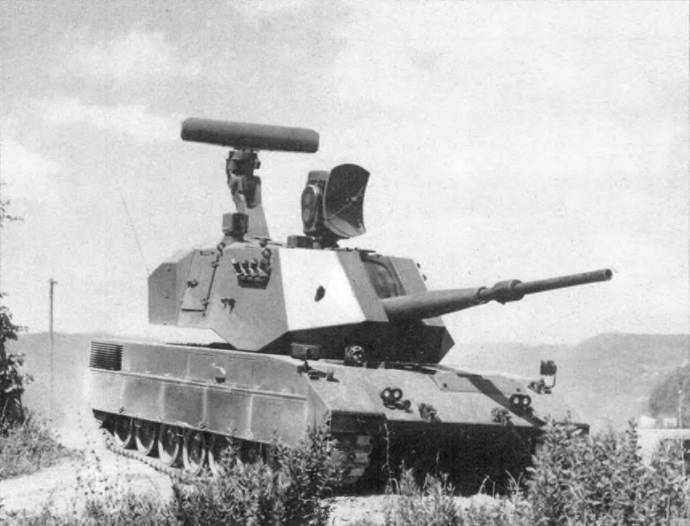
Experienced ZSU OTOMATIC on the OF-40 chassis. Photo by Wikimedia Commons
With all their advantages, self-propelled anti-aircraft installations with small-caliber guns have a serious drawback in the form of a limited firing range. An interesting solution to this problem was proposed in the Italian OTOMATIC self-propelled gun project. To increase the range and reach in height, as well as to enhance the impact on the target, it was proposed to use an automatic gun of 76 mm caliber.
For military air defense
By the mid-eighties, it became clear that ZSU with small-caliber guns had a lot of problems, and their time was running out. In this regard, the Italian company OTO Melara, on its own initiative, began the development of a new self-propelled gun with improved performance. In the future, it was planned to offer it to the Italian and foreign military. The project received the designation OTO Main Anti-aircraft Tank for Intercept and Combat ("Main anti-aircraft tank for interception and combat from OTO") or abbreviated as OTOMATIC.
The Otomatic project provided for the construction of a ZSU based on ready-made components. The chassis for it was borrowed from an experienced tank OF-40. The possibility of using other bases was considered. The artillery part was completed on the basis of the OTO Melara 76 mm ship installation. At the same time, it was necessary to develop a fire control system and some other means from scratch. In addition, the possibility of creating adjustable projectiles was studied.
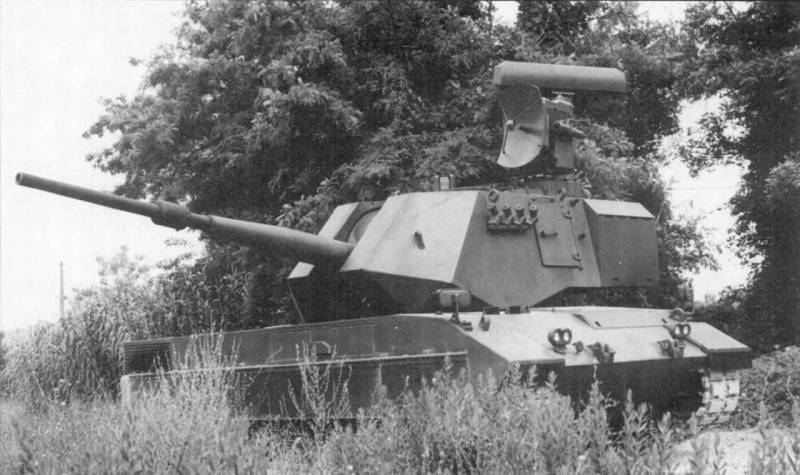
The machine is on trial. Photo of Wikimedia Commons
The first prototype of the new ZSU was built in 1987. By the end of the year, he went to the test. Under the conditions of the landfill, the operation of various systems and units, as well as their interaction, was checked. Radar and optical means were worked out and firing was carried out in all modes. In general, the experimental machine confirmed the calculated characteristics, but also showed some shortcomings.
Technical features
The OTOMATIC product was a self-propelled anti-aircraft gun on a tracked tank chassis; weapons and fire control equipment were placed in a full-revolving turret. When using the OF-40 chassis, the vehicle had a length (without guns) of approx. 7,3 m (9,6 m with the gun forward) with a width of 3,7 m and a height of 3,1 m. The combat weight was 46 tons. The crew included four people - the driver, commander, gunner and loader.
The chassis of the OF-40 tank was built in an armored hull with combined anti-projectile protection of the frontal projection and homogeneous protection of the remaining areas. A 750 hp MTU brand diesel engine was used, located in the stern. The undercarriage had seven road wheels with torsion bar suspension on each side. The running characteristics of the ZSU generally corresponded to the original tank. The maximum speed reached 65 km / h, cruising range - 500 km.
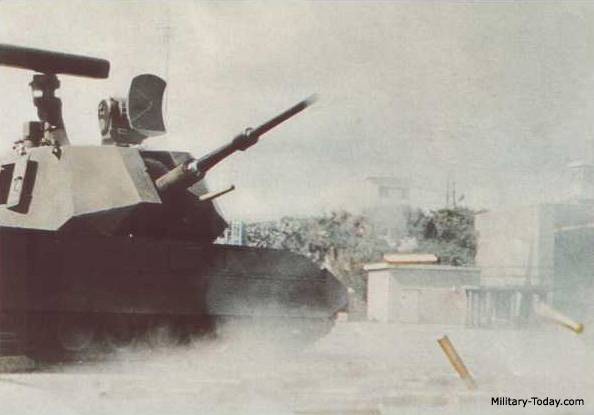
Fire tests. Spent cartridges are ejected through a window under the gun. Photo military-today.com
On the basis of the ship's artillery mount, a fighting compartment was developed for the land chassis. It was carried out in a large armored turret with the main armament in the front. Inside were the loading mechanisms and crew seats. On the roof placed the means of detection and guidance.
A 76-mm rifled gun with a barrel length of 62 klb was used. It differed from the original ship gun by the presence of an ejector and some other design features. Provision was made for advanced recoil devices; recoil energy was used for reloading. The swinging artillery unit gave aiming angles from -5 ° to + 60 °. Horizontal guidance - circular. Guidance was carried out by hydraulics in the presence of backup manual drives.
Directly under the gun, in the gap of the shoulder strap of the hull, there was an automatic loader. It was made on the basis of the units of the ship installation, but rebuilt to fit in a limited volume. The machine gun provided firing single or bursts of up to six shots. Technical rate of fire - 120 rds / min. 26 shells were placed vertically in the circular conveyor of the machine gun. Another 44 were in the stowage in the nose of the hull - the loader was responsible for reloading them into the machine gun.
To combat air targets, a shot with a high-explosive fragmentation projectile was intended. The latter weighed 6,35 kg and had an initial speed of 910 m/s. A warhead with semi-finished hard alloy submunitions and a radio fuse was used. The maximum firing range reached 10-11 km.
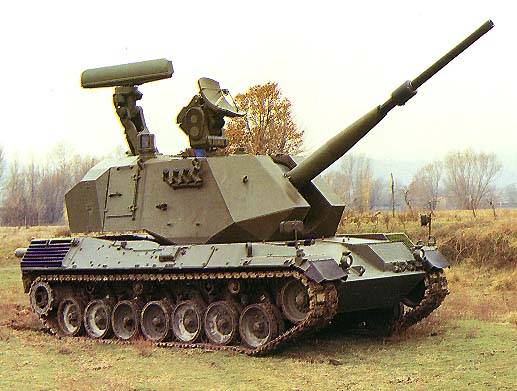
Prototype on Leopard 1 chassis. Photo by Alternathistory.com
The ZSU "Otomatic" could also deal with ground protected targets, for which an armor-piercing sub-caliber projectile was included in the ammunition load. The initial speed of more than 1600 m/s made it possible to penetrate the armor of armored personnel carriers and obsolete tanks at distances of at least 1-1,5 km.
The fire control system was completed using several electronic and optical means. The search and tracking of air targets was carried out by a VPS-A05 pulse-Doppler radar with a rotating antenna on the roof of the tower. Aircraft were taken for escort from a distance of 15 km, helicopters hovering from 8 km. At least 8 objects were tracked at the same time.
To aim the gun, a VPS-F06 millimeter radar with an oscillating antenna was used. It had a range of at least 10 km and high accuracy in determining coordinates. In addition, the commander and gunner had optoelectronic devices with a laser rangefinder, designed for use in difficult jamming conditions or when the radar breaks down.
The SLA also included a ballistic computer, operator and commander consoles, and other means. The crew could choose the modes of operation of equipment and weapons, differing in varying degrees of automation. He also determined the type of projectile used, the length of the queue, etc.
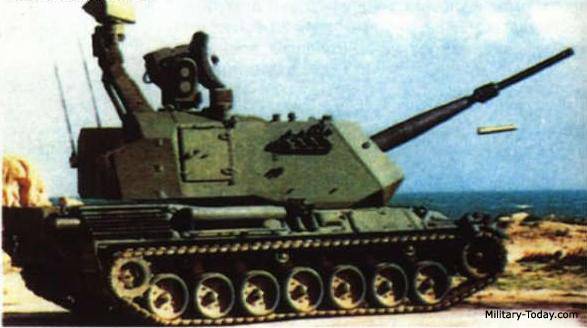
Shooting at an air target. Photo military-today.com
Benefits and Prospects
The first prototype ZSU OTOMATIC was built on the chassis of the OF-40 tank. Such a combat vehicle showed high performance characteristics, but its future was in doubt. Italy and other countries showed no interest in the basic MBT and would hardly order equipment based on it. In this regard, it was decided to move the fighting compartment to a new base.
At the turn of the eighties and nineties, a new version of the "Otomatic" on the chassis of the Leopard 1 tank came out for testing. The armament complex as a whole remained the same, with the exception of some improvements made according to the test experience. In 2010, the improved and rebuilt turret with a 76 mm gun was transferred to the Centauro chassis. The resulting sample was named Draco. Both options for upgrading customers were not attracted.
Despite the difficulties with the chassis, the fighting compartment as a whole showed high performance. The calculated range and accuracy parameters were confirmed. In addition, the tests showed all the advantages of the 76 mm caliber. Larger shells flew further and were also more powerful. So, three high-explosive fragmentation projectiles with a radio fuse were equivalent to two dozen 40-mm products in their effect on the target.
In the future, corrective projectiles could be created for the 76-mm guns. Due to aerodynamic rudders or impulse engines, it was possible to improve accuracy and provide an almost direct hit on the target with a clear result. In this case, the OTOMATIC installation could compete with the near-field air defense system.
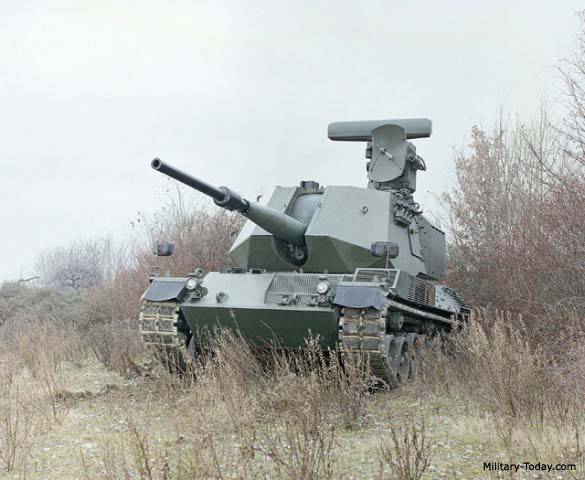
ZSU based on the "Leopard" at the training ground. Photo military-today.com
However, the self-propelled gun did not reach the series. According to the results of the tests, it became clear that "Otomatic", with all the advantages, has a number of disadvantages. First of all, a limited firing range was noted - in this respect, the ZSU was seriously inferior to the existing military air defense systems. At the same time, increasing the distance was accompanied by a sharp drop in accuracy, and maneuvering targets were an extremely difficult task.
OTO Melara continued work on OTOMATIC until the second half of the nineties. And without receiving a single order, she stopped development. At the end of the XNUMXs, an attempt was made to seriously modernize the fighting compartment and transfer it to a new chassis. This project also did not interest the army. More work on "Otomatic" was not resumed.
Unsolved problems
Thus, the OTOMATIC project by OTO Melara ended with mixed results. The designers as a whole managed to solve the problems of the range and power of the ammunition, but they could not get rid of other characteristic shortcomings of the ZSU. The overall effectiveness of self-propelled guns against typical targets was insufficient, and not a single country wanted to adopt it.
Over the past years, the situation in the air has changed - new threats have appeared in the form of high-precision weapons and unmanned aerial vehicles. Perhaps, under such conditions, the ZSU OTOMATIC or another similar sample could show high efficiency. However, as far as we know, the old project is finally closed, and there are no plans to resume it.
Information